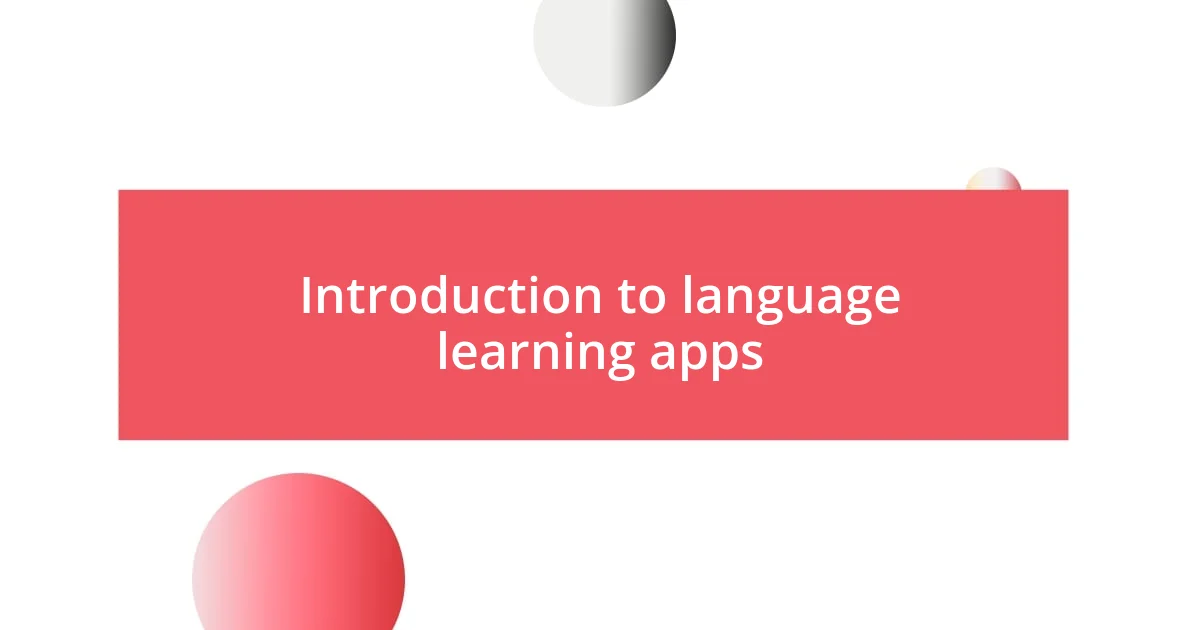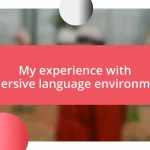Key takeaways:
- Language learning apps provide personalized learning paths, engaging multimedia resources, and social interaction, enhancing the learning experience and motivation.
- Duolingo’s gamified approach fosters engagement through playful challenges, while Babbel offers structured lessons focusing on real-life conversation and grammar comprehension.
- Combining different apps can enhance language learning, allowing users to enjoy both casual and in-depth study methods to find what suits their style best.

Introduction to language learning apps
Language learning apps have revolutionized the way we acquire new languages. I still remember the challenge of learning Spanish years ago—finding time among my busy schedule felt impossible. Enter the world of apps! Suddenly, I had a pocket-sized tutor ready to help me practice any time, anywhere.
These digital tools cater to various learning styles, making the process enjoyable and engaging. Have you ever found yourself lost in a lesson, feeling that exhilarating sense of accomplishment when you finally grasp a tricky concept? That’s the magic that a good language app can offer, turning mundane study into an interactive experience.
Moreover, many apps incorporate gamification elements that keep learners motivated. I’ve found myself eagerly logging in daily, drawn by the points and badges, as if I were on a quest. It’s fascinating how these small rewards can transform learning into a game, fueling our desire to dive deeper into new languages.

Top features of language apps
One of the standout features of language learning apps is their ability to offer personalized learning paths tailored to individual progress. I remember when I first used an app that adjusted its lessons based on my performance. It felt like I had a personal coach—one that quickly recognized my strengths and weaknesses and guided me accordingly. This level of customization not only kept me engaged but also made my learning journey more efficient.
Another impressive feature is the range of multimedia resources available within these apps. From videos and podcasts to interactive exercises, each element caters to different learning preferences. For instance, I once watched a cooking video in French while trying to follow along with the recipe! This blend of context and creativity not only made the language more relatable but also allowed me to connect with the culture in a tangible way. It’s these little moments that truly elevate the learning process.
Lastly, social interaction elements found in many language apps cannot be overlooked. Engaging with a community of learners has been incredibly rewarding for me. Whether it’s through chats or challenges, I’ve made friends across the globe, practicing my skills in a way that felt natural and fun, rather than just academic. It’s amazing how sharing the journey with others can enhance motivation and accountability.
| Feature | Description |
|---|---|
| Personalized Learning Paths | Adjust lessons based on the learner’s performance and preferences. |
| Multimedia Resources | Offer a variety of content like videos, podcasts, and exercises to cater to different learning styles. |
| Social Interaction | Facilitate communication and collaboration among learners through chats or challenges. |

My favorite language learning apps
Language learning apps have become indispensable tools in my journey to mastering new languages. I still fondly remember the thrill I felt the first time I could confidently order food in Italian during my travels. It’s those small victories that keep me returning to my favorite apps, making each session feel less like a chore and more like an exciting quest.
Here are my top picks for language learning apps:
– Duolingo: Its gamified approach makes learning feel like play, and I can’t help but chase my daily streak!
– Babbel: The structured courses resonate with my tendency to jump into practical conversations right away.
– Busuu: I cherish the opportunity to receive feedback from native speakers; it’s a bridge to authentic learning experiences.
– Memrise: The use of spaced repetition has significantly boosted my vocabulary retention, and the videos of native speakers are a delightful touch.
– Rosetta Stone: I’ve always appreciated its immersive method, allowing me to think in the language rather than just translate in my head.
Each app his personal stories and emotions connected to my language learning journey, making them special in their own right.

Detailed review of app one
Duolingo has captured my heart with its playful approach to language learning. The first time I stumbled upon a “gem,” I felt a rush of excitement, as if I had discovered a hidden treasure in my language journey. It wasn’t just about vocabulary—every correct answer sent a spark of joy through me, encouraging me to push just a little further. Who would have thought that learning could be so addictive?
What really stands out for me is the app’s gamification aspect, which transforms mundane lessons into enjoyable challenges. I remember competing with friends to see who could maintain the longest streak; the friendly rivalry motivated me to log in daily. Have you ever felt that sense of achievement from a simple notification? It’s incredible how a little reminder can reignite the desire to learn, making each session feel more like an adventure rather than a chore.
Furthermore, the bite-sized lessons are perfect for my busy lifestyle. Just the other day, I squeezed in a quick session while waiting for my coffee, and I walked away feeling accomplished. It’s those small moments that matter, allowing me to learn on the go. In our fast-paced world, finding a language app that fits seamlessly into daily life is indispensable. With Duolingo, I truly feel like I can learn anywhere, anytime, and that’s a game-changer for anyone on this journey.

Detailed review of app two
When it comes to Babbel, I can’t help but appreciate its structured approach to language learning. I remember sitting on my couch one rainy afternoon, following one of its interactive lessons focused on ordering food at a restaurant. The way the content was laid out made it feel like I was building a real conversation rather than just memorizing random phrases. Have you ever felt like a lesson actually resonated with you? That moment when I realized I could almost visualize myself ordering pizza in Italian made all the difference.
What truly sets Babbel apart for me is the emphasis on conversation. Every lesson feels relevant, and I enjoy how they build on one another. I recall practicing a dialogue about traveling, and the next day I found myself using those very phrases while talking to my Italian friend. It’s wonderful how real-life application breathes life into language learning. Do you think there’s a better way to learn than seeing immediate results? I’ve found that with Babbel, those results are not just theoretical; they become a part of your everyday interactions.
Another aspect I value is Babbel’s focus on grammar. It presents grammar rules in a straightforward manner, which helps me internalize the language’s structure. I distinctly remember being a bit intimidated by verb conjugations at first, but the app’s engaging explanations turned my apprehension into confidence. Reflecting on this experience, I realize how crucial understanding grammar is for sounding more fluent. It’s this kind of insight that makes Babbel an essential tool in my language-learning arsenal.

Comparing app features and effectiveness
When comparing app features and effectiveness, I find it fascinating how each app tailors its approach to fit different learning styles. For instance, while Duolingo thrives on gamification, creating a fun, competitive atmosphere, Babbel’s structured lessons feel more like attending a virtual classroom. Did you ever notice how your mood changes depending on the style of learning? I certainly do, and that’s why experimenting with both has been so enlightening for me.
That said, I’ve also observed that Duolingo’s bite-sized lessons are ideal for quick sessions, which is a lifesaver during my busy days. One evening, while I was waiting for a dinner to cook, I completed three mini-lessons in just ten minutes. Those tiny sessions reminded me that learning doesn’t have to be a marathon; sometimes, a sprint is all you need. On the other hand, I appreciate how Babbel’s lessons often require more reflection and time, encouraging depth over speed. It’s like savoring a good meal rather than just grabbing a snack—each has its place.
Ultimately, I believe the effectiveness of these apps boils down to personal preferences and goals. Do you learn better through playful engagement, or do you prefer a methodical approach? I’ve found that switching between apps enhances my overall experience. It’s all about finding what resonates with you and makes language learning not just effective but enjoyable.

Conclusion and recommendations
Reflecting on my journey with these language-learning apps, I can’t stress enough the importance of finding the right fit for your learning style. There’s so much out there! I remember the first time I switched from a rigid program to one that offered more interactive elements; it was like unlocking a door to a vibrant world of engaging content. Are you ready to explore different options until you find one that clicks for you?
In my experience, combining apps has been a game-changer. One evening, after a particularly grueling day, I found the motivation to dive into a Duolingo session. Just five minutes in, I was smiling at the silly characters and light-hearted challenges. The laughter helped ease my stress and reignited my passion for learning. Isn’t it amazing how a little fun can enhance your motivation and retention?
For anyone looking to enhance their language skills, I recommend you give both structured and gamified approaches a try. Maybe start with Babbel for a solid foundation and sprinkle in Duolingo when you want something lighter. Whatever path you choose, the key is to stay curious and enjoy the process. How has your experience been so far?















